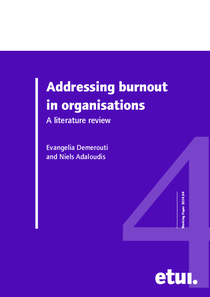Addressing burnout in organisations: A literature review

Demerouti, Evangelia ; Adaloudis, Niels
European Trade Union Institute, Brussels
ETUI - Brussels
2024
36
burnout ; occupational health ; working conditions ; diagnosis ; definition
Working Paper
2024.04
Psychosocial risks
English
Bibliogr.
1994-4446
13.04.5-68697
"Since its introduction in 1974, the concept of burnout has generated a lot of scientific research. The World Health Organization only recently recognised it as an occupational phenomenon, defined as a ‘prolonged response to chronic emotional and interpersonal stressors on the job and characterized by the three dimensions of exhaustion, cynicism, and inefficacy'. This paper provides a scoping literature review of burnout and possible interventions. The literature suggests that the current measurement instruments are not appropriate for diagnostic purposes, and their scores overlap substantially with other disorders, such as fatigue, anxiety and depression. A valid diagnosis of burnout requires a combination of questionnaire and interview data, including information about its causes. The review discovered that the main triggers of burnout are chronic exposure to high job demands and low job resources. Whereas individual characteristics (such as neuroticism) make some people more prone to burnout, there is no clear picture of what personality characteristics entail a higher risk. Burnout has detrimental effects on both individuals and organisations, however. Burnout interventions typically focus on stress-relief and coping strategies to deal with the high level of job demands, but their effects diminish over time. Research also shows that organisations focus primarily on the consequences of burnout, while more attention should be given to the underlying causes within the job. Evidence from organisational interventions shows that organisations can improve their employees' working conditions to reduce burnout risk. Combined interventions show promise: they allow the organisation to develop a healthy work environment, while employees can deal adequately with (sporadic) stress. Social partners need to urge governments and policymakers to support research on burnout to develop clear diagnosis and treatment of burned-out employees together with preventive measures to reduce the psychosocial risks in the work environment."
Digital;Paper
ISBN (PDF) : 1994-4454
Legal deposit : D/2024/10.574/05
The ETUI is co-funded by the European Union. Views and opinions expressed are however those of the author(s) only and do not necessarily reflect those of the European Union or the ETUI.